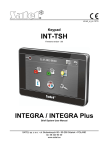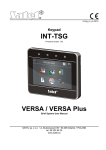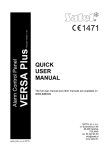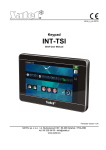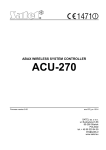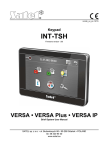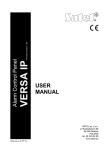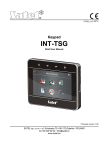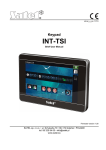Download INT-TSG
Transcript
int-tsg_oi_en 05/15 Keypad INT-TSG Firmware version 1.03 INTEGRA / INTEGRA Plus Brief System User Manual SATEL sp. z o.o. • ul. Budowlanych 66 • 80-298 Gdańsk • POLAND tel. 58 320 94 00 www.satel.eu WARNINGS Please read this manual carefully before use. Changes, modifications or repairs not authorized by the manufacturer shall void your rights under the warranty. SATEL's goal is to continually upgrade the quality of its products, which may result in alterations of their technical specifications and firmware. The current information on the introduced modifications is available on our website. Please visit us: http://www.satel.eu The declaration of conformity may be consulted at www.satel.eu/ce The following symbol may be used in this manual: - note. We are pleased that you have chosen a product offered by us. We wish you satisfaction with your choice and would like to assure you that we are always ready to provide professional assistance and information on our products. SATEL Ltd. is a manufacturer of a wide variety of dedicated devices for use in alarm systems. Additional information can be found on our website www.satel.eu or at points of sale offering our products. 1. Keypad description 1.1 LED indicators LED Color yellow green Description of indications blinking – trouble or trouble memory (the LED goes off when the partitions operated by the keypad are armed) ON – all partitions operated by the keypad are armed blinking – some partitions operated by the keypad are armed or exit delay countdown is running blinking – service mode is entered red ON or blinking – alarm or alarm memory green Information about the armed state can be extinguished after a time period defined by the installer. If the installer has enabled the GRADE 2 (INTEGRA) / GRADE 3 (INTEGRA Plus) option: the LED will indicate alarms only after user authorization (entering the code); blinking of the LED means that there is a trouble in the system, some zones are bypassed, or that there was an alarm. 2 INT-TSG SATEL 1.2 Touch screen The screen enables communication between the user and the alarm system. It displays information about the system status, while allowing you to operate and program the alarm system, as well as control the home automation equipment. Intuitive icon-based menu makes the everyday use easier. The keypad offers two operating modes: graphical mode – large icons are displayed without description, verbose mode – small icons are displayed with description. To change the operating mode, use the following icons: – tap to switch over the screen to the verbose mode, – tap to switch over the screen to the graphical mode. This manual describes how to operate the keypad, based on the graphical mode. Tapping an icon or icon description will display the next screen or start the specified function. The icon will bring you back to the previous screen. Tapping the icon will display the main screen. After 10 minutes of keypad inactivity, the screen saver is displayed (slide show or clock) or the screen goes blank (the mode of operation is to be defined by the installer). Tapping the screen when it is blank or the screen saver is displayed will wake up the keypad. The keypad can also be woken up e.g. on opening the door, detecting motion by a detector etc. The installer defines the content which is to be displayed after the keypad wake-up (status screen, main screen or start of the disarming procedure). During the keypad inactivity period, messages about arming/disarming, entry/exit delay countdown, alarm etc. can be displayed on the screen. 1.2.1 Slide show The slide show can be displayed as the status screen background or the screensaver. The pictures to be displayed should be saved to a microSD memory card, which will be put into the keypad by the installer. The installer defines the speed at which the pictures will change during the slide show. 1.2.2 Status screen SATEL INT-TSG 3 The status screen is displayed 60 seconds after the last operation performed on the keypad screen, unless the terminal is running (see p. 13). When the terminal is displayed, the status screen may appear later or even not appear at all (e.g. when the service menu is open). If the user is logged in, he/she will be automatically logged out a few seconds after the status screen is displayed. Information presented on the status screen The keypad with factory settings presents the date and time on the status screen. The installer can customize the information displayed to suit the user needs. Information on the state of selected partitions, zones or outputs, temperature taken by selected temperature detectors, date and time, as well as any text, can be presented on the status screen. Icons illustrating the state of partitions are described in section “Partition status” (p. 8). Icons illustrating the state of zones are described in section “Zone status” (p. 9). Icons illustrating the state of outputs are shown in the table below. Icon Color Output status grey deactivated red activated Additional messages, connected with occurrence of specific events (e.g. arming or disarming, auto-arming delay countdown, entry / exit delay countdown, alarm, etc.), may also appear on the status screen. Functions available from the status screen Tapping the status screen will display the main screen. The keypad can be configured by the installer so as to display the macro commands assigned to a corresponding group on tapping the corner of status screen. The illustration below shows the screen parts, the tapping of which can display macro commands (the digit corresponds to the number of macro command group). Icons of macro command groups can be displayed there. Pressing any part of the status screen for 3 seconds may trigger the silent panic alarm. Whether or not this function will be available is to be defined by the installer. 4 INT-TSG SATEL Status screen background A single picture or a slide show can be displayed as the status screen. The status screen background is to be configured by the installer. 1.2.3 Main screen Presented on the main screen are: date and time in the format defined by the installer (if some specific events occur, other messages can be displayed, instead of the date and time, e.g. entry or exit delay countdown, alarm messages, etc.); name of the currently logged user; icons enabling operation of the keypad and alarm system. Icon Function Informs you that no user is logged in. User login. Informs you that a user is logged in (name of the currently logged user is displayed below). User logout. Displays the “Arming” screen (see pages 5 and 14). Enables disarming / alarm clearing (see pages 6, 16 and 17). Enables control of the alarm system and home automation devices (see p. 6). Displays the “System status” screen (see p. 8). Displays the “Emergency” screen (see p. 10). SATEL INT-TSG 5 Displays the “Advanced” screen (see p. 11). 1.2.4 Authorization screen Some screens and functions may only be available after user authorization. The authorization is code based. Use the number keys to enter the code and then confirm, tapping the icon. By default, the following codes are preprogrammed in the control panel: service code: 12345 object 1 master (administrator) code: 1111 If you make a mistake when entering the code, tap and re-enter the code (if you fail to enter the valid code within one minute, information on entering a wrong code will be saved to the control panel memory). 1.2.5 “Arming” screen 6 INT-TSG Icon SATEL Function Enables arming in mode “full”. Enables arming in mode “full + bypasses”. Enables arming in mode “without interior”. Enables arming in mode “without interior and without entry delay”. 1.2.6 “Alarm clearing / Disarming” screen The “Alarm clearing / Disarming” screen will be displayed after you tap the icon on the main screen, when there is an alarm (alarm memory) and at least one partition is armed. Icon Function Enables alarm clearing. Enables disarming. 1.2.7 “Control” screen The “Control” screen will be displayed on tapping the icon on the main screen, if macro commands are assigned to at least two groups of macro commands. It presents the groups of macro commands. Up to 4 groups can be programmed by the installer. Tapping a group SATEL INT-TSG 7 icon will display macro commands assigned to that group. Up to 16 macro commands can be assigned to one group. If macro commands are assigned only to one group, tapping the icon will display the macro commands at once. In the keypad with factory settings, two macro commands are programmed and assigned to the first group (the figure below shows the screen to be displayed on a keypad with factory settings). The control panel will execute the factory programmed macro commands, provided that the alarm system is suitably configured by the installer. You should consult the installer about which additional macro commands would facilitate operation of the alarm system or control of the home automation devices connected to the control panel. Only the installer can program any additional macro commands. Icon Function Quick full arming (without user authorization by using a code) – in a similar way as after pressing the 0 keys on the keypad with text menu. Exit delay clearing – in a similar way as after pressing the 9 the keypad with text menu. keys on The keypad can be configured by the installer so as to start the function of output control from the terminal on tapping the may be required). icon (tapping and holding the icon for about 3 seconds 8 INT-TSG SATEL 1.2.8 “System status” screen Icon Function Displays the “Partition status” screen. Displays the “Zone status” screen. Displays the “Troubles” screen, on which the current troubles are presented (the installer can configure the control panel to display the troubles until cleared). Enables viewing the event log. Displays the “Alarm log” screen, on which alarms stored in the control panel memory are presented. Displays the “Trouble log” screen, on which troubles stored in the control panel memory are presented. icon is available at the When viewing the log of events, alarms or troubles, the top of the screen. Tapping the icon will toggle the information presentation mode: light grey / color font (and the other way round). Partition status The status of partitions is illustrated by means of icons. Tap the icon situated at the top of the screen to see description of all icons. The number shown next to the icon corresponds to the partition number. On tapping the icon, the full partition name will be presented at the display bottom. SATEL Icon INT-TSG 9 Partition status disarmed – there are no violated zones disarmed – there are violated zones exit delay countdown is running – remaining time longer than 10 seconds exit delay countdown is running – less than 10 seconds remained armed – mode: “full” armed – mode: “full + bypasses” armed – mode: “without interior” armed – mode: “without interior and without entry delay” temporarily blocked entry delay countdown is running fire alarm alarm fire alarm memory alarm memory Zone status The status of zones is illustrated by means of icons. The icons are designated by numbers corresponding to the zone numbers. On tapping the icon, the zone number and text information about the zone state is presented at the top of the display. Icon Zone status normal violated 10 INT-TSG trouble – long violation trouble – no violation bypassed tamper alarm alarm tamper alarm memory alarm memory tamper masking masking memory 1.2.9 “Emergency” screen Icon Function Tapping and holding for 3 seconds will trigger the fire alarm. SATEL SATEL INT-TSG 11 Tapping and holding for 3 seconds will trigger the medical (auxiliary) alarm. Tapping and holding for 3 seconds will trigger the panic alarm. The installer defines, whether the loud panic alarm (with a loud alarm signal) or the silent one (without a loud signal) will be triggered. 1.2.10 “Advanced” screen In the lower right corner of the screen you will find information on the keypad firmware version. Icon Function Locking the touch screen for 30 seconds (to clean the screen). Displays the “Backlight” screen. Displays the “Volume” screen Enables updating of the keypad firmware (the function is available after entering the service code). Enables formatting of the microSD card (the function is available after entering the service code). Displays the terminal. 12 INT-TSG SATEL Backlight Intensity of the screen backlight can be controlled within the 10-100% range. In the night hours, which can be specified, the backlight intensity can be different. Volume You can define the volume level of sounds generated: when operating the keypad (tapping the keys, confirmation of performed operation, etc.). after zone violation (CHIME signal). when signaling the entry delay. when signaling the exit delay. when signaling fire alarms. when signaling burglary, panic and medical alarms. SATEL INT-TSG 13 Terminal The terminal enables the alarm system to be operated and programmed in the same way as from the LCD keypad with text menu. The method of using such a keypad is described in the control panel programming / user manuals (electronic versions of the manuals are available on the www.satel.eu website). 1.3 Sound signaling The installer can disable the sound signaling. 1.3.1 Beeps generated when using the icon-based menu 1 short beep – tapping a key on the authorization screen or selecting/deselecting a field when choosing the partitions and event type. 2 short beeps – confirmation of executing a function, command, etc. 2 long beeps – incorrect code, function unavailable or return from the main screen back to the status screen. 1.3.2 Beeps generated when using the terminal 1 short beep – tapping a number key. 2 short beeps – confirmation of command execution, signaling of entering the user menu, submenu or function. 3 short beeps – signaling of: – starting the arming procedure (there is exit delay in the partition) or arming (there is no exit delay in the partition); – disarming and/or alarm clearing; – turning output off; – disabling chime signal in the keypad, using the key; – exiting the function and returning to the menu after confirmation of the data entered. 4 short beeps and 1 long beep – signaling of: – turning output on; key; – enabling chime signal in the keypad, using the – ending the function and exiting the user menu after confirmation of the data entered. 14 INT-TSG SATEL 1 long beep – signaling of: – violated / bypassed zones when arming; – fault of the vibration detector (10. 24H VIBRATION type zone was not violated during the vibration detector test run upon starting the arming procedure). 2 long beeps – incorrect code, function not available or exiting the function without confirmation of the data entered (e.g. by using the 3 long beeps – unavailable function. key). 1.3.3 Events signaled by sounds Only installer selected events are signaled. Alarms are being signaled throughout the time programmed by the installer. 5 short beeps – zone violation (CHIME). Long beep every 3 seconds, followed by a series of short beeps for 10 seconds and 1 long beep – countdown of exit delay (if the time is shorter than 10 seconds, only the final sequence of short beeps will be generated). A sequence of 7 beeps of diminishing duration, repeated every few seconds – countdown of auto-arming delay. 2 short beeps every seconds – countdown of entry delay. 2 short beeps every 3 seconds – signaling a new trouble. Continuous beep – alarm. Long beep every second – fire alarm. 2. Operating the alarm system This section describes selected operations which can be executed using the icon-based menu. The description does not include the user authorization, which will be required when using the keypad. The alarm system is operated from the terminal in the same way as when using the LCD keypad with text menu. For description of the alarm system operation by means of LCD keypad with text menu, please refer to the control panel user manual. 2.1 Arming Completion of the steps below will start the arming procedure. The procedure ends when the exit delay time elapses (if the countdown is completed successfully, the system becomes armed – see also “Failure of arming procedure” p. 16). If the exit delay time is 0, the system becomes armed instantly. For further information on arming, arming modes, etc., please refer to the user manual for INTEGRA or INTEGRA Plus control panels. This section describes the operations which must be performed to arm the system in the "full" mode. To arm the system in other mode you should proceed in much the same way, except that instead of the icon for arming the system in the "full" mode you should tap other icon. The installer can prepare macro commands to simplify the arming procedure (especially, for the system subdivided into many partitions). SATEL INT-TSG 15 2.1.1 Full arming of all partitions 1. Tap on the main screen. The “Arming” screen will be displayed. 2. Tap . The selection screen will be displayed (if you have only access to 1 partition from the given keypad, the partition arming procedure will start immediately). . The arming procedure will start in all partitions to which the user has access 3. Tap from the keypad. 2.1.2 Full arming of selected partitions 1. Tap on the main screen. The “Arming” screen will be displayed. 2. Tap . The selection screen will be displayed. 3. Tap . The screen showing partitions by means of suitably described fields will be displayed. Tap a field to select the partition. The icon will be displayed in the field (the full partition name will appear at the bottom of the screen). When you finish selecting the partitions, tap . The arming procedure will be initiated in the partitions. If a field is tapped and held for 3 seconds: the the icon will appear in all fields – if the icon will appear in all fields – if the icon was displayed in the field, icon was displayed in the field. 2.1.3 Quick arming The installer can permit arming without entering the user code. The partitions indicated by the installer will be armed. The installer should be consulted whether and how the quick arming will be possible. The keypad factory settings allow for quick full arming in the following manner: 1. Tap the upper left corner of the status screen. Macro commands assigned to the first group will be displayed. 2. Tap . The arming procedure will begin. 2.1.4 Denial of arming The installer can program the control panel so that the arming procedure could not be started, if: – a zone is violated in the partition; – there is a trouble in the system (including tamper); – there was a verified alarm. In such a case the terminal will be displayed and a message specifying the cause of refusal. Additionally, the message can prompt action which you can take: “1=Ok” - on tapping the key, you will be brought back to the previous screen (arming is impossible); 16 INT-TSG SATEL “1=Arm” - on tapping the key, the system will be armed despite the violated zone or trouble (forced arming); “2=Check” - on tapping the key, you will be able to view the list of violated / bypassed zones or troubles. When viewing the list of violated / bypassed zones, you can bypass / unbypass the currently displayed zone by tapping the key. 2.1.5 Failure of arming procedure The installer can program the control panel so that the arming procedure will fail if, when the exit delay countdown ends: – there is a violated zone in the partition which was not violated when the arming procedure was started; – there is a trouble which did not exist when the arming procedure was started. 2.2 Disarming If there is an alarm (alarm memory), disarming will result in simultaneously clearing the alarm. Tap on the main screen. Depending on the system state: I. There is no alarm (alarm memory) and 1 partition is armed / you have access to 1 partition The partition will be disarmed. II. There is an alarm (alarm memory) and 1 partition is armed / you have access to 1 partition . The partition will The “Alarm clearing / Disarming” screen will be displayed. Tap be disarmed. III. There is no alarm (alarm memory) and at least 2 partitions are armed The selection screen will be displayed. Tap if you want to disarm all partitions to which you have access from the keypad. if you want to select the partitions which are to be disarmed. The screen Tap showing the partitions by means of suitably described fields will be displayed. Tap a field to select the partition. The icon will be displayed in the field (the full partition name will appear at the bottom of the screen). When you finish selecting the partitions, tap to disarm them. IV. There is an alarm (alarm memory) and at least 2 partitions are armed The “Alarm clearing / Disarming” screen will be displayed. Tap instructions given in it. III above. and then follow the SATEL INT-TSG 17 2.3 Alarm clearing (without disarming) Tap on the main screen. Depending on the system state: I. There is an alarm (alarm memory) and none of the partitions is armed The alarm will be cleared. II. There is an alarm (alarm memory) and at least 1 partition is armed The "Alarm clearing / Disarming" screen will be displayed. Tap cleared. . The alarm will be 2.4 Viewing the event log 2.4.1 Viewing all events 1. Tap on the main screen. The “System status” screen will be displayed. 2. Tap . The “Event log” screen will be displayed. 3. Tap . The last three events stored in the control panel memory will be displayed. The icon allows you to view previous events. 2.4.2 Viewing the selected events 1. Tap on the main screen. The “System status” screen will be displayed. 2. Tap . The “Event log” screen will be displayed. 3. Tap . The “Event log (selected)” screen will be displayed. 4. Tap . The screen presenting event types will be displayed. 5. Tap the event types which are to be shown, and then tap to the previous screen, on which an extra . You will be brought back icon will appear. 6. If only events from selected partitions are to be shown, tap . The screen showing partitions by means of suitably described fields will be displayed. Tap a field to select the partition. The icon will be displayed in the field (the full partition name will appear at the bottom of the screen). When you finish selecting the partitions, tap you back to the previous screen. . It will take 7. Tap . The last three events which are stored in the control panel memory and meet the selected criteria will be displayed. The icon allows you to view previous events. 18 INT-TSG SATEL 3. Manual update history Manual version 02/14 05/15 The list of changes Information on the verbose mode and how the operating mode can be changed has been added (p. 2). Note about screen turning off after 10 minutes of keypad inactivity has been added (p. 2). Information on the possibility to display icons of macro command groups on status screen has been added (p. 3). Note about icon available when viewing the event, alarm or trouble log has been added (p. 8). Information on the icon available when viewing the status of partitions (p. 8) has been added. Icon illustrating the temporarily blocked partition status has been changed (p. 9). Information on the new icon available on the "Advanced" screen has been added (p. 11). Description of the "Backlight" screen has been added (p. 12). Name of the manual has been changed. Information on the keypad operation after 10 minutes of inactivity has been modified (p. 2). Description of the slide show has been modified (p. 2). Information on the status screen background has been added (p. 4). Section describing the authorization screen has been modified (p. 5). Information on the new icon available on the “Advanced” screen has been added (p. 11). Description of the “Volume” screen has been added (p. 12).




















